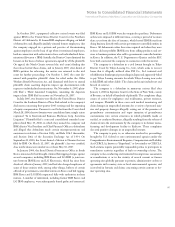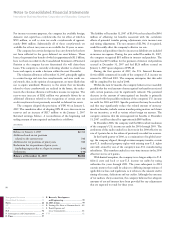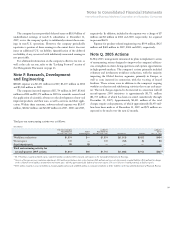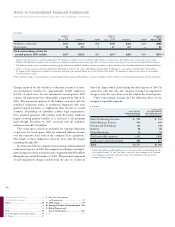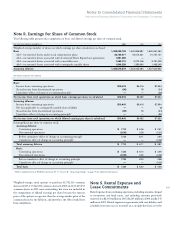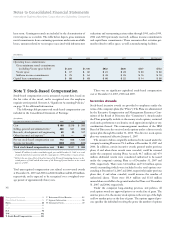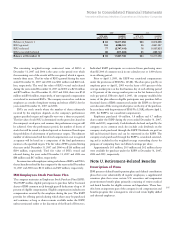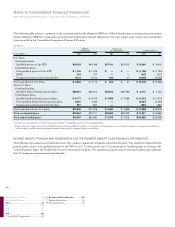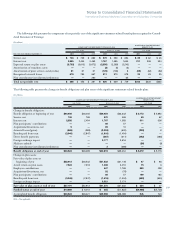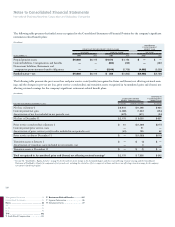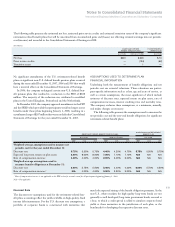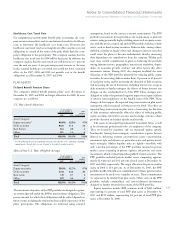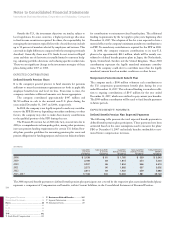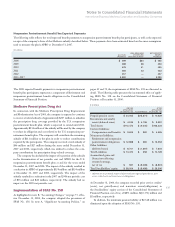IBM 2007 Annual Report Download - page 107
Download and view the complete annual report
Please find page 107 of the 2007 IBM annual report below. You can navigate through the pages in the report by either clicking on the pages listed below, or by using the keyword search tool below to find specific information within the annual report.
105
Notes to Consolidated Financial Statements
International Business Machines Corporation and Subsidiary Companies
2007 2006
WTD. AVG. NUMBER WTD. AVG. NUMBER
GRANT PRICE OF UNITS GRANT PRICE OF UNITS
Balance at January 1 $ 84 10,217,258 $83 6,813,698
RSUs granted 104 4,929,141 85 4,831,227
RSUs released 77 (2,747,110) 76 (1,037,927)
RSUs canceled/forfeited 88 (511,543) 85 (389,740)
Balance at December 31 $ 94 11,887,746 $84 10,217,258
The remaining weighted-average contractual term of RSUs at
December 31, 2007 and 2006 is the same as the period over which
the remaining cost of the awards will be recognized, which is approx-
imately three years. The fair value of RSUs granted during the years
ended December 31, 2007 and 2006 was $513 million and $410 mil-
lion, respectively. The total fair value of RSUs vested and released
during the years ended December 31, 2007 and 2006 was $213 million
and $79 million. As of December 31, 2007 and 2006, there was $740
million and $501 million, respectively, of unrecognized compensation
cost related to nonvested RSUs. The company received no cash from
employees as a result of employee vesting and release of RSUs for the
years ended December 31, 2007 and 2006.
PSUs are stock awards where the number of shares ultimately
received by the employee depends on the company’s performance
against specified targets and typically vest over a three-year period.
The fair value of each PSU is determined on the grant date, based on
the company’s stock price, and assumes that performance targets will
be achieved. Over the performance period, the number of shares of
stock that will be issued is adjusted upward or downward based upon
the probability of achievement of performance targets. The ultimate
number of shares issued and the related compensation cost recognized
as expense will be based on a comparison of the final performance
metrics to the specified targets. The fair value of PSUs granted during
the years ended December 31, 2007 and 2006 was $116 million and
$104 million, respectively. Total fair value of PSUs vested and
released during the years ended December 31, 2007 and 2006 was
$88 million and $67 million, respectively.
In connection with employee vesting and release of RSUs and PSUs,
the tax benefits realized by the company for the years ended December
31, 2007 and 2006 were $133 million and $59 million, respectively.
IBM Employees Stock Purchase Plan
The company maintains an Employees Stock Purchase Plan (ESPP).
The ESPP enables eligible participants to purchase full or fractional
shares of IBM common stock through payroll deductions of up to 10
percent of eligible compensation. Eligible compensation includes any
compensation received by the employee during the year. The ESPP
provides for offering periods during which shares may be purchased
and continues as long as shares remain available under the ESPP,
unless terminated earlier at the discretion of the Board of Directors.
Individual ESPP participants are restricted from purchasing more
than $25,000 of common stock in one calendar year or 1,000 shares
in an offering period.
Prior to April 1, 2005, the ESPP was considered compensatory
under the provisions of SFAS No. 123(R). The share price paid by an
employee prior to April 1, 2005 was the lesser of 85 percent of the
average market price on the first business day of each offering period
or 85 percent of the average market price on the last business day of
each pay period. Effective April 1, 2005, the company modified the
terms of the plan whereas eligible participants may purchase full or
fractional shares of IBM common stock under the ESPP at a five-per-
cent discount off the average market price on the day of the purchase.
In accordance with the provisions of SFAS No. 123(R), effective April 1,
2005, the ESPP is not considered compensatory.
Employees purchased 4.0 million, 5.8 million and 6.7 million
shares under the ESPP during the years ended December 31, 2007,
2006 and 2005, respectively. Cash dividends declared and paid by the
company on its common stock also include cash dividends on the
company stock purchased through the ESPP. Dividends are paid on
full and fractional shares and can be reinvested in the ESPP. The
company stock purchased through the ESPP is considered outstand-
ing and is included in the weighted-average outstanding shares for
purposes of computing basic and diluted earnings per share.
Approximately 16.3 million, 20.3 million and 26.2 million shares
were available for purchase under the ESPP at December 31, 2007,
2006 and 2005, respectively.
Note U. Retirement-Related Benefits
Description of Plans
IBM sponsors defined benefit pension plans and defined contribution
plans that cover substantially all regular employees, a supplemental
retention plan that covers certain U.S. executives and nonpension
postretirement benefit plans primarily consisting of retiree medical
and dental benefits for eligible retirees and dependents. These ben-
efits form an important part of the company’s total compensation and
benefits program that is designed to attract and retain highly skilled
and talented employees.


